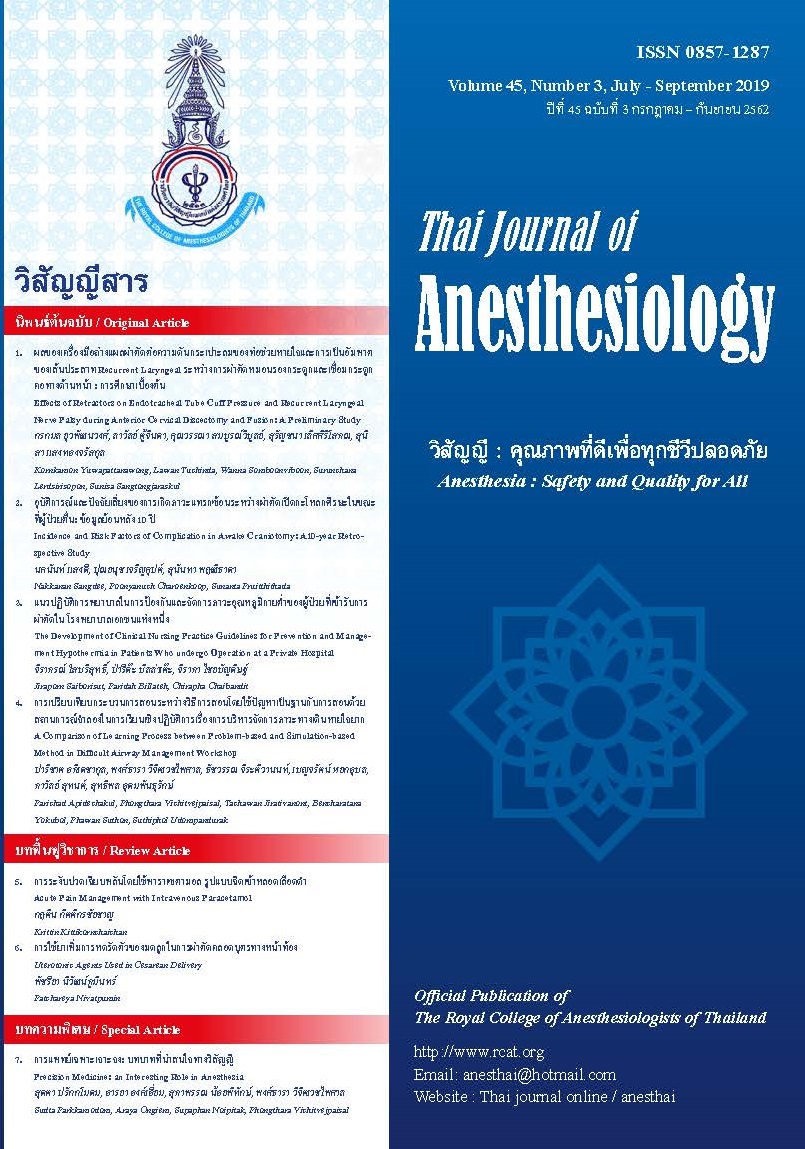A Comparison of Learning Process between Problem-based and Simulation-based Method in Difficult Airway Management Workshop
Main Article Content
Abstract
Introduction: Teaching and learning in airway management
are essential in the anesthetic field. Problem-based and
simulation-based learning manifests the superior benefit
of the instructional process and learning content. The
teachers’ and students’ viewpoints on these two learning
methods would help to reflect the future setting of the
anesthesia training program.
Objective: To compare the teachers’ viewpoints on
problem-based and simulation-based learning, and to
compare students’ viewpoints on these two learning
techniques.
Methods: A prospective, questionnaires-based study was
performed amongst 10 anesthesiologists and 37 Nurse
student anesthesia. After stratified random assignment,
students simultaneously attended either simulation-based
learning (SBL) or problem-based learning (PBL) course
one at a time. Six weeks later, a crossover technique was
applied to both groups. Teachers and students responded
to 4-point Likert scale for these two learning methods.
Teachers’ questionnaires were based on the learning
contents; while, students’ matters comprised learning
content, process, and evaluation.
Results: The learning process of SBL showed statistically
significant differences as compared to PBL (2.7±0.3 vs
2.6±0.4; p=0.024). However, there were no significant
differences in term of content and evaluation techniques
of the two learning methods amongst students. On the
other hand, the staff showed a statistically significant
difference in the evaluation of the airway (1.5±0.6 vs
2.6±0.4; p=0.01) and follow up care (1.9±0.7 vs 2.5±0.4;
p=0.03) by means of PBL.
Conclusions: Amongst Learning content, process and
evaluation, students showed their favor of the Learning
process under SBL. Whereas, staff revealed that the
Evaluation of the airway and Follow up care other than
Patient preparation and Strategic planning, had priority by
means of PBL.
Article Details
References
1. Lee WS, Cho KC, Yang SH, Roh YS, Lee GY. Effects of
problem-based learning combined with simulation on the
basic nursing competency of nursing students. J Korean
Acad Fundam Nurs 2009;16(1):64-72.
2. Linder LA, Pulsipher N. Implementation of simulated learning
experiences for baccalaureate pediatric nursing students.
Clin Simul Nurs 2008;4(3):e41-7.
3. Reilly A, Spratt C. The perceptions of undergraduate student
nurses of high-fidelity simulation-based learning: A case
report from the University of Tasmania. Nurse Educ Today
2007 ; 27(6):542-50.
4. Rowan CJ, McCourt C, Beake S. Problem based learning in
midwifery–The students’ perspective. Nurse Educ Today
2008;28(1):93-9.
5. Brown ST, Kirkpatrick MK, Greer A, Matthias AD, Swanson
MS. The use of innovative pedagogies in nursing education:
an international perspective. Nurs Educ Perspect 2009;30(3):
153-8.
6. Lorello GR, Cook DA, Johnson RL, Brydges R. Simulation-based
training in anaesthesiology: a systematic review and
meta-analysis. Br J Anaesth 2014;112(2):231-45.
7. Chilkoti G, Mohta M, Wadhwa R, Saxena AK. Problem-based
learning research in anesthesia teaching: current status and
future perspective. Anesthesiol Res Pract 2014;2014:
263948
8. Al-Elq AH. Simulation-based medical teaching and learning.
J Family Community Med 2010 ;17(1):35-40.
9. Liu PL, Liu LMP. A practical guide to implementing problembased
learning in anaesthesia. Curr Anaesth Crit Care 1997;
8(4): 146–51.
10. Chin KL, Yap CYL, Lee WL, Soh YC. Comparing effectiveness
of high-fidelity human patient simulation vs case-based
learning in pharmacy education. Am J Pharm Educ 2014;
78(8):153.
11. Steadman RH, Coates WC, Huang YM, et al. Simulation-based
training is superior to problem-based learning for the
acquisition of critical assessment and management skills.
Crit. Care Med 2006;34(1):151-7.
12. Feingold CE, Calaluce M, Kallen MA. Computerized patient
model and simulated clinical experiences: Evaluation with
baccalaureate nursing students. J Nurs Educ 2004;43(4):
156-63.
13. Szögedi MI, Boncz I, Betlehem JI K, Fekete JPD. The
problem-based learning as a new practical method of skill
development in the health sciences higher education. Value
in Health ;3,032(7): A249.
14. Smithburger PL, Kane-Gill SL, Ruby CM, Seybert AL.
Comparing effectiveness of 3 learning strategies:
simulation-based learning, problem-based learning, and
standardized patients. Simul Healthc 2012;7(3):141-6.
15. Couto TB, Farhat SCL, Geis GL, Olsen O, Schvartsman C.
High-fidelity simulation versus case-based discussion for
teaching medical students in Brazil about pediatric
emergencies. Clinics (Sao Paulo) 2015 ;70(6):393-9.
16. Chen HC, Marsh TD, Muller J. Introducing physical
examination practice into problem-based learning. Med
Educ 2007;41(11):1087-8.
17. McFetrich J. A structured literature review on the use of high
fidelity patient simulators for teaching in emergency
medicine. Emerg Med J 2006;23(7):509-11.
18. Gurpinar E, Musal B, Aksakoglu G, Ucku R. Comparison of
knowledge scores of medical students in problem-based
learning and traditional curriculum on public health topics.
BMC Med Educ 2005;5(1):7.
19. Koenig HM. No more difficult airway, again! Time for
consistent standardized written patient notification of a
difficult airway. APSF newsletter 2010;25(2).
20. Kadis J, Loskove J. Communicating and managing the
difficult airway: one health care system’s story. APSF
Newsletter 2012;27:29-44.


